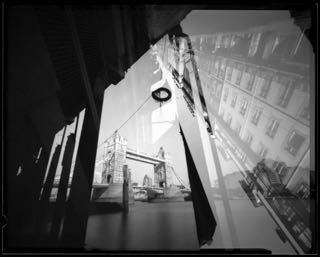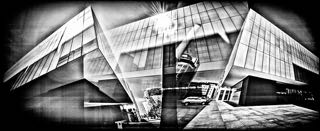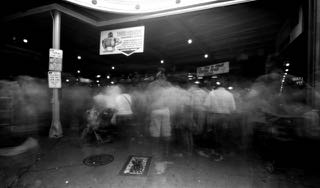Markus Kaesler is a German photographer with a level of intent to his multi exposure work that is rarely seen. As you’ll soon see, the photos below require a care in execution that is as meticulous as it is devoted. What follows are samples from two of Markus’s projects. The first, CONTACTS, are multi exposures taken from cities connected by his travels. The second, in between, are whole travel exposures that record the experience as travel between places.
After viewing these, I implore you to take a look at Markus’s website for more of his work. Markus first reached out to us through our Call for Entry and will be included in the upcoming ƒ/D book. If you’re so inclined, I recommend that you also consider responding to our Call for Entry!
CONTACTS.
//crossing cities is a visual melting pot of cities. It links pairs of cities in different countries and unites them in a unique photographic way; one part of the pinhole images is taken in one city, the other part in its corresponding. On the same sheet of film. Every place has its very own character, determined by cultural values, religion and geographical settings. Keeping this in mind, the overlaying of cities in two different countries into a series of images that contains essential parts of both places does not only mean the physical crossing of borders. By using a technique of twisted double exposures, images are created that may be looked at from both sides. Depending on whichever side you look at, you may focus on different patterns of the image. And oversee others. The diversity of the places is shown in the same way as new ties are revealed. New forms and structures become visible, while the specific character of the places remains. The previous known adds up and leads to the unknown. The exposures float into each other. A kind of in between appears. The alphabet serves as a pattern. The cities are selected by the first letter of their names in english spelling. From that results the extent of 52 cities in 52 different countries.
Berlin//Bucharest 01
[singlepic id=426 w=600]CONTACTS Berlin//Bucharest 01 – ©Markus Kaesler 2016[/singlepic][spacer height=”20px”]
Paris//Prague 02
[singlepic id=431 w=600]CONTACTS Paris//Prague 02 – ©Markus Kaesler 2016[/singlepic][spacer height=”20px”]
Berlin//Bucharest 04
[singlepic id=427 w=600]CONTACTS Berlin//Bucharest 04 – ©Markus Kaesler 2016[/singlepic][spacer height=”20px”]
London//Lissabon 07
[singlepic id=429 w=600]CONTACTS London//Lissabon 07 – ©Markus Kaesler 2016[/singlepic][spacer height=”20px”]
London//Lissabon 08
[singlepic id=430 w=600]CONTACTS London//Lissabon 08 – ©Markus Kaesler 2016[/singlepic][spacer height=”20px”]
Berlin//Bucharest 10
[singlepic id=428 w=600]CONTACTS Berlin//Bucharest 10 – ©Markus Kaesler 2016[/singlepic][spacer height=”20px”]
in between
„in between“ shows the space between two places. The whole time of a journey banned on light sensitive paper. You see the resulting light traces that are painted on light sensitive paper during its journey crossing borders of countries and continents. The exposure starts in one country and ends in another. What you see is the “ in between“. Why do I care so much about the materials I use? If you consider photography as a storytelling art, you will recognize that the used material is part of the story. It makes a difference if a sheet of light sensitive paper actually has travelled thousands of miles while being exposed or if its just a piece of paper where the visual impression of a voyage is printed on. Some may say, that for the final visible impression it doesn’t matter how an image has been created. I oppose this, that the creating process is part of the resulting work. The true story may only be told by the one who experienced it.
BKK-SIN
[singlepic id=432 w=600]in between BKK-SIN – ©Markus Kaesler 2016[/singlepic][spacer height=”20px”]
FRA-BKK
[singlepic id=433 w=600]in between FRA-BKK – ©Markus Kaesler 2016[/singlepic][spacer height=”20px”]
FRA-IST
[singlepic id=434 w=600]in between FRA-IST – ©Markus Kaesler 2016[/singlepic][spacer height=”20px”]
TPE-HKG
[singlepic id=435 w=600]in between TPE-HKG – ©Markus Kaesler 2016[/singlepic][spacer height=”20px”]



